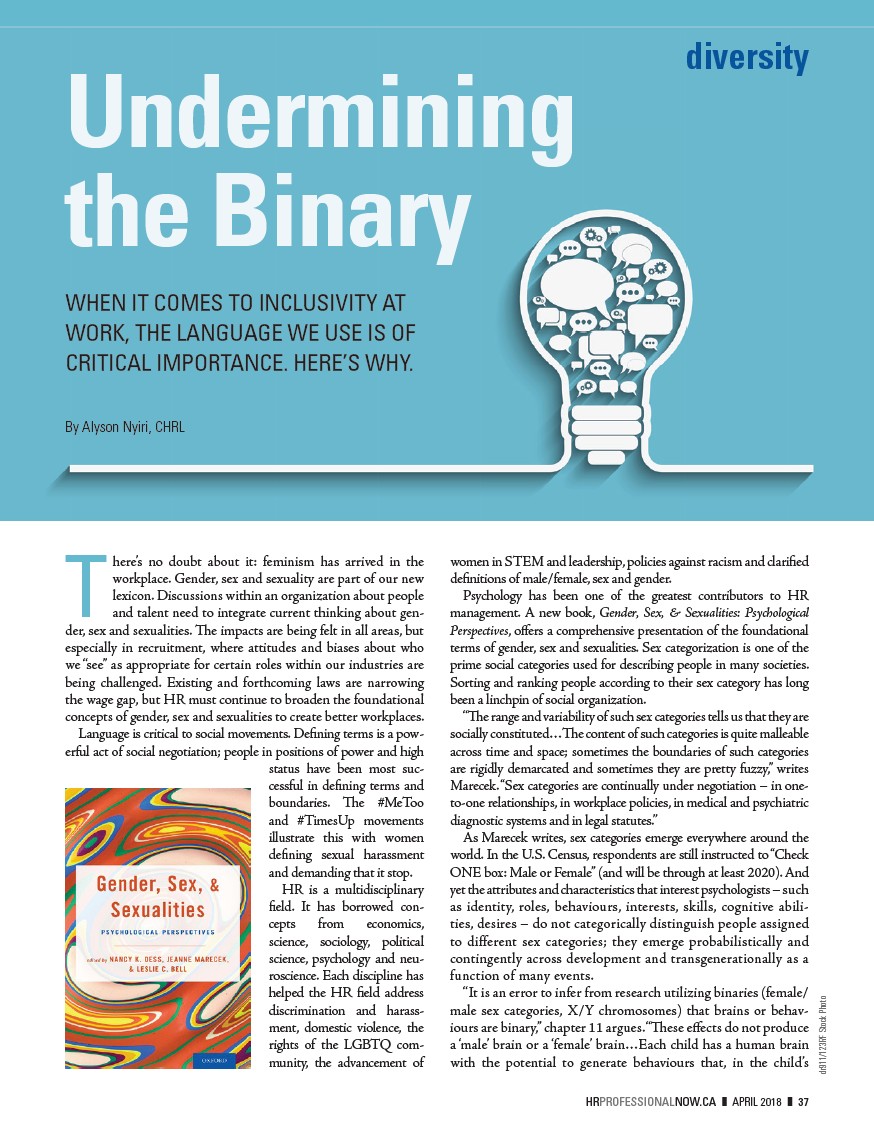
diversity
Undermining
the Binary
WHEN IT COMES TO INCLUSIVITY AT
WORK, THE LANGUAGE WE USE IS OF
CRITICAL IMPORTANCE. HERE’S WHY.
There’s no doubt about it: feminism has arrived in the
workplace. Gender, sex and sexuality are part of our new
lexicon. Discussions within an organization about people
and talent need to integrate current thinking about gender,
sex and sexualities. The impacts are being felt in all areas, but
especially in recruitment, where attitudes and biases about who
we “see” as appropriate for certain roles within our industries are
being challenged. Existing and forthcoming laws are narrowing
the wage gap, but HR must continue to broaden the foundational
concepts of gender, sex and sexualities to create better workplaces.
Language is critical to social movements. Defining terms is a powerful
act of social negotiation; people in positions of power and high
status have been most successful
in defining terms and
boundaries. The #MeToo
and #TimesUp movements
illustrate this with women
defining sexual harassment
and demanding that it stop.
HR is a multidisciplinary
field. It has borrowed concepts
from economics,
science, sociology, political
science, psychology and neuroscience.
Each discipline has
helped the HR field address
discrimination and harassment,
domestic violence, the
rights of the LGBTQ community,
the advancement of
By Alyson Nyiri, CHRL
dr911/123RF Stock Photo
women in STEM and leadership, policies against racism and clarified
definitions of male/female, sex and gender.
Psychology has been one of the greatest contributors to HR
management. A new book, Gender, Sex, & Sexualities: Psychological
Perspectives, offers a comprehensive presentation of the foundational
terms of gender, sex and sexualities. Sex categorization is one of the
prime social categories used for describing people in many societies.
Sorting and ranking people according to their sex category has long
been a linchpin of social organization.
“The range and variability of such sex categories tells us that they are
socially constituted…The content of such categories is quite malleable
across time and space; sometimes the boundaries of such categories
are rigidly demarcated and sometimes they are pretty fuzzy,” writes
Marecek. “Sex categories are continually under negotiation – in oneto
one relationships, in workplace policies, in medical and psychiatric
diagnostic systems and in legal statutes.”
As Marecek writes, sex categories emerge everywhere around the
world. In the U.S. Census, respondents are still instructed to “Check
ONE box: Male or Female” (and will be through at least 2020). And
yet the attributes and characteristics that interest psychologists – such
as identity, roles, behaviours, interests, skills, cognitive abilities,
desires – do not categorically distinguish people assigned
to different sex categories; they emerge probabilistically and
contingently across development and transgenerationally as a
function of many events.
“It is an error to infer from research utilizing binaries (female/
male sex categories, X/Y chromosomes) that brains or behaviours
are binary,” chapter 11 argues. “These effects do not produce
a ‘male’ brain or a ‘female’ brain…Each child has a human brain
with the potential to generate behaviours that, in the child’s
HRPROFESSIONALNOW.CA ❚ APRIL 2018 ❚ 37